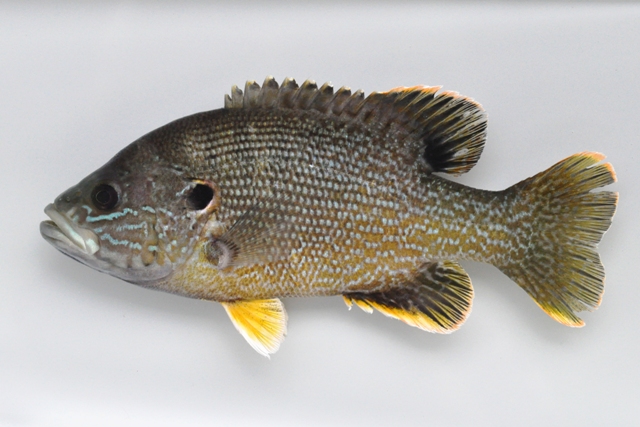Green Sunfish
(Lepomis cyanellus)

Green sunfish frequently become overcrowded in small water bodies when conditions are poor. They are very tolerant of turbid (murky water) and often hybridize with other species of sunfish, especially bluegill sunfish. They are very aggressive which makes them easy to catch on a fishing line.
Description
Green sunfish have a moderately compressed body, but are not as deep bodied as bluegill and other sunfish species. They have a large mouth and the upper jaw extends back to the middle of the eye. The pectoral fins are short and rounded. Green sunfish have a dark olive green colored body with iridescent blue lines on their cheek. They also have rows of small iridescent blue speckles on their body. All of the fins, except the pectoral fins, have an orange, yellow, or white outline. They often have a black spot near the back of the dorsal and anal fins where they attach to the body. The opercle (ear flap) is black and sometimes has a thin white to yellow-orange margin.
Habitat and Habits
Green sunfish are native to Ohio and are found throughout the state. They are very tolerant to poor water quality and are often the only sunfish found in very muddy waters. They do have a strong preference to hide around structure such as rocks, logs, or brush piles. They are quite often the only sunfish found in very small streams. Both green sunfish and bluegill readily hybridize with other species of sunfish, most often each other. Hybrids between two other sunfish species are relatively rare.
Reproduction and Care of the Young
Green sunfish are communal spawners with males constructing nests in shallow water from mid-May to August. The female then lays between 2,000 to 26,000 eggs. Males defend the nest for the three to five days it takes the eggs to hatch and then will try to entice another female to deposit a new batch of eggs in his nest. Green sunfish tend to spawn in shallower water, and dig deeper nests than bluegill sunfish. Male green sunfish can sometimes be found trapped in their nest if there is a sudden drop in water level because they build their nests so close to shore.